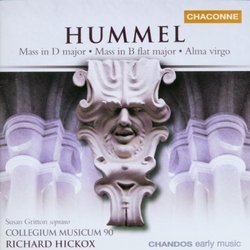| All Artists: Johann Nepomuk Hummel, Richard Hickox, Collegium Musicum 90, Susan Gritton Title: Hummel: Mass in D Major, Op. 111; Mass in B-Flat Major, Op. 77; Alma virgo Members Wishing: 1 Total Copies: 0 Label: Chandos Release Date: 1/21/2003 Genre: Classical Styles: Chamber Music, Historical Periods, Classical (c.1770-1830) Number of Discs: 1 SwapaCD Credits: 1 UPC: 095115068120 |
Search - Johann Nepomuk Hummel, Richard Hickox, Collegium Musicum 90 :: Hummel: Mass in D Major, Op. 111; Mass in B-Flat Major, Op. 77; Alma virgo
 | Johann Nepomuk Hummel, Richard Hickox, Collegium Musicum 90 Hummel: Mass in D Major, Op. 111; Mass in B-Flat Major, Op. 77; Alma virgo Genre: Classical |
Larger Image |
CD Details |
CD ReviewsExcellent Masses in the Style of Haydn--and Hummel! 03/26/2004 (5 out of 5 stars) "While I'd heard good things about Hummel's choral music, I approached this disc with some trepidation. I hoped that, unlike Hummel's concerted music, his choral music wouldn't pay undo homage to Mozart, a composer whose liturgical music always sounds like it wants to be opera. Instead, I found that Hummel, who succeeded Haydn as Kappelmeister at the Esterhazy estate, followed much more in his distinguished predecessor's footsteps. In fact, these two masses--like Haydn's late masses written for the feast day of Nicolas Esterhazy's wife Marie Hermenegild--have many Haydnesque touches. The stately, serious-minded opening Kyrie movement of the Mass in D reminded me of the similar section in Haydn's Mass in Time of War. In the Mass in B-flat Major, Hummel displays considerable fugal abilities, in the Amen of the Gloria, writing with the same tight, propulsive quality that marks the fugues in Haydn's two finest masses, The Mass in Time of War and the Lord Nelson Mass, both responses to difficult times for the allies during the Napoleonic Wars.But the gentle coloristic effects in the D Major Mass--the clarinets and horns at the start of the Credo, the solo organ at the start of the Agnus Dei, which imparts an especially sober quality to the proceedings--these mark Hummel as very much his own man and indicate the two masses are in no way slavish imitations. In fact, there is a fully Beethovenian quality (early middle Beethovenian, anyway) in the lively Et resurrexit with its odd, declamatory writing for the timpani; is that the stone rolling away from the tomb?Anyway, one large difference between these masses and those of Haydn--and Mozart and Beethoven, for that matter--is that they lack parts for the vocal quartet that is typical of Viennese mass of the day. Hummel's are all-choral masses, so the composer must put his chorus alone through the wide emotional gamut that the liturgical text demands, meaning the choral writing needs to be constantly resourceful. And I think Hummel brings considerable resources to the job at hand. These are fine masses, indeed, that supply as it were the missing choral-music link between Haydn and Beethoven.The offertory Alma virgo was also written for one of the feast days, and it is a bright, celebratory work that recalls some of Mozart's works for soprano and chorus. Susan Gritton is the attractive soloist in this piece.Richard Hickox conducts his forces with great understanding, responding with equal sympathy to the rather slender prettiness of the Alma virgo and the far grander statements of the two masses. The chorus is excellent, and the orchestra, although a period-instrument orchestra, plays with such mellifluousness and beauty of tone, it will make you marvel to recall the gritty, scrappy sounds such orchestras made at the birth of the original-instruments movement. Chandos supplies a drier, tighter acoustic than in some of its choral recordings. This has advantages in terms of clarity. If your Latin is good, you won't need the follow the text. Bu0 speaking of text, here is one gripe: The booklet that came with my CD was all messed up: I got two "gathers" of pages 27-29 but none of pages 23-26. The result? Much of the text of the mass was left out (though I did get two copies of the advertising section of the booklet), and the English-language notes were also missing. I had to settle for reading the notes in French (my German not being up to snuff). Tres etrange!"
|
